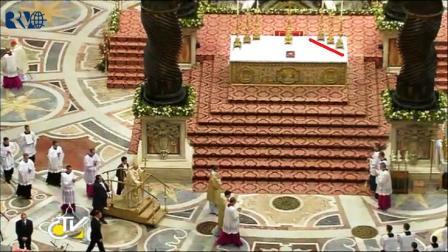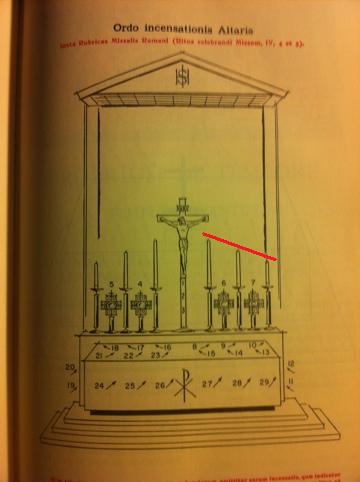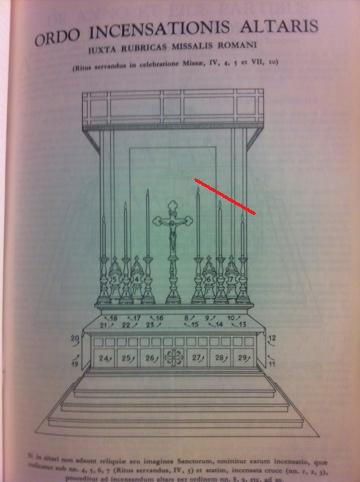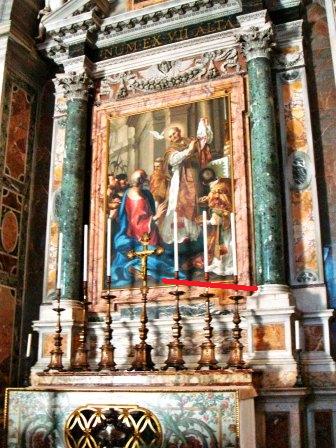Under another entry, a commentator asked:
Why [were] the altar candles sometimes in line (as for the Mass of 1 Jan) and sometimes in echelon (as at Christmas Midnight Mass).
I think he was asking about putting the candles at an angle. Here is a screenshot from Midnight Mass.

I don’t know why they are that way. Maybe a nun set them up. It is eery how Italian nuns are incapable of putting any two or more candles in a straight line parallel to the edge of an altar.
However, there is another way in which candles can be in echelon, and this is part of the Roman style. The candles on a Roman altar are, in at different levels.
In the front of an older Roman Missal you will see a diagram of how an altar is to be incensed. Note that the candles are at different heights.


And here is a shot of a side altar in St. Peter’s Basilica. You can see that the candles sticks are different heights.

In the video of the Pope’s Midnight Mass, at the very beginning there is a shot of a side altar. You can see the candle sticks are at different levels.
In any event, I thought I would share some Roman lore for your opportune knowledge.


































I have noticed that the candles on the altar at St. Peter’s are never arranged the same way twice (consecutively, that is), and I imagine it is for variety’s sake, alone. Sometimes the cross and candles are all evenly-spaced across the length of the altar, other times the candles are more consolidated, leaving more space between the innermost candles and the crucifix. Sometimes all the candlesticks are of the same height, other times they are of different heights (a variety of different sets are used).
Interestingly, the candles and cross, when they are all lined-up in a parellel line, are always placed very near the edge of the altar, whereas in pre-Conciliar times, they were usually arranged in the center of the altar:
http://whitearoundthecollar.blogspot.com/2010/05/extraordinary-from-of-roman-rite.html
I imagine they are placed near the edge, now, simply because the current sacristy is unaware that they used to be arranged in the middle and imagines that near the edge seems the logical place for them (since altar cards are no longer used).
What is the Extraordinary “From”? [?]
I have no problem with whether or not they are in echelon or in a line. However, what I CAN’T STAND is when somebody puts two or three candles on one side of the altar and a flower arrangement on the other. That is just plain weird looking.
I just assumed it was because the candles form less of a barrier between the pope and the congregation when they’re at an angle. Some of Benedict’s masses appear very Roman and very traditional (eg. Jan. 1). Others appear to be much more “ordinary” like the Mass on Christmas. I remember that the first time we saw the Benedictine arrangement years ago, the seven candles were spaced equally across the altar, like they were before the Council. Then they were almost immediately rearranged as they have been since to leave an opening in the middle that would allow for a better line of sight. I have no idea, but I imagine someone involved wanted the people to be able to see the Pope, or the Pope to be able to see the people.
I have tried to point out to sacristans and priests that flower arrangements, boom boxes, and other stuff do not belong on the altar. This is a huge problem in convents, monasteries, parishes in the Midwest and some parts of England. I am sure it is against the Rules….
Another rule which is broken, and those with more knowledge can chime in, is that only fresh cut flowers are allowed in the sanctuary or in front of the sanctuary and not potted plants or (eeiiuu) fake flowers or dried flowers. Again, I have tried to deal with this in Iowa and elsewhere in the States, and gave up.
There are several parishes in the Davenport Diocese and convents, where the candles are placed on one side and a plant on the other for daily Mass. I must admit, except for the Jesuits, I have not seen that in Malta. But, I have seen dried and fake flowers by the altar. As to candles, almost every church there uses oil lamps. I am assuming this is an ancient custom. Does anyone know about the use of oil instead of candles? The pillars or tapers look like candles, but are actually oil lamps at the top. Saw this everywhere.
By the way, in Malta, I was trying to buy beeswax candles for myself and found out this was virtually impossible. One man I worked with there told me that they were hard to get outside the country market, which was only open on Sunday and I do not shop on Sunday. He also told me that the Mason use beeswax candles for their rituals, which is creepy. Where they get them, I did not found out for obvious reasons.
Centristian,
Could it be that in pre-conciliar times communion was not distributed from the papal altar (I don’t know if this was the case or not) and thus the current practice is to allow more room for ciboria?
Those must have been some rather strong nuns setting up those candles.
Actually, in the first camera shot I saw of these echelon-arranged candles, from directly in front of the altar and from the level of the people on the floor of St. Peter’s, they looked correct–that is, like they were in a straight line with the two toward the center of the altar being longest, the two towards the ends of the altar being shortest, and the other two intermediate in length.
It was only when I later saw a different angle that I saw they were angled in placement, rather than of different heights. Could this be the salutary intent?
I like disco’s answer…very funny.
However, I believe that the Master of Pontifical Ceremonies is the ultimate responsibility (after the Pope) for the arrrangements at the High Altar in St Peter’s. Marini would do nothing without the Pope’s approval. The candles on the altar are often changed from a single line of 7 to the angular arrangement as it pic seen by Fr Z. Perhaps Marini just does this according to the way he feels on the day !! One the exterior altar in the piazza I have seem them angled.
In the end, does it really matter? They are huge anyway and no one person, and certainly no nun could lift them. |I have seen men lift them and they would do what Marini 1 and Marini 2 wanted/ wants. QED
I just like the instruction on how to incense an altar! How beautiful and complete.
It’s been a long time since I looked at it, but according to Geoffrey Webb’s book, The Liturgical Altar, which is based on legislation in force up to the 1930s, it was preferred that the candles be different heights as shown in the incensation diagrams which Fr. Z has posted. Having all the candles of equal heights, whether on candlesticks of identical or descending heights was merely tolerated.
Another point in Webb’s book was that flowers, if used, had to be natural. Artificial flowers could be used if they were well made of metal or silk. However, Webb noted that decorating by adding extra candles was preferred to using flowers.
The Liturgical Altar was recently reprinted by Romanitas Press, and is a real eye-opener.
It’s either in the Dark Night of the Soul or the Ascent of Mount Carmel, I can’t remember which, where John of the Cross warns people about worrying about candles. I wish I could remember which book it was.
One perverse custom I’ve seen all too often is where a candle or candles will be placed on the floor in front of an altar at one corner, and one or more candles will be placed on the altar on the opposite corner. It looks extremely silly, especially when older candlesticks are used.
It’s the Ascent of Mount Carmel Chapter 43 #2. I opened my book 2 pages from where it was.
TNCath – I’m glad it’s not just me who hates that asymmetry on altars! Mercifully, it’s rarely seen here in the UK, but was rife when I went to Brugges in Belgium earlier in the year. I’m sure St. John is right not to worry about candles, but I wouldn’t have to worry if priests, nuns, and assorted ‘liturgists’ would just arrange them properly!
Speravi:
“Could it be that in pre-conciliar times communion was not distributed from the papal altar (I don’t know if this was the case or not) and thus the current practice is to allow more room for ciboria?”
I’m not sure about that. I never see an overcrowding of metalware on the altar during a papal liturgy and they would have needed, at any rate, as many ciboria before the Council as after. Additionally, at a solemn Mass at St. Peter’s before Pope Paul’s…boringization, the altar was further cluttered with two large bronze statues of St. Peter and St. Paul, as well as the papal tiara and the pope’s mitres with their stands (in addition to the missal and missal stand, the pontifical, the huge burse, &c), and still the candles were arranged across the center:
http://www.flickr.com/photos/francisjasondiazperez/2438231424/
Even with the candles and cross arranged across the center so as to cut the usable space of the altar in half, it is such a huge altar that there remains plenty of space to accomodate alot of extras. So I still imagine that when they first restored the traditional arrangement a few years ago, it had just been so long since it was done that the central positioning of the appointments was simply forgotten. Someday, though, I’ll bet some papal sacristan or MC will look at an old picture and say, “hey guys, look at this: they used to line them up in the center; we’re doing it wrong.”
I also get the impression that they are doing alot of experimenting at St. Peter’s, trying different ways to reconcile the “old” look with the “new” liturgy, to make it all work. Before Pope Benedict came along they never even tried to reconcile the two. Now the mentality is, to this Pope’s credit, that the glory of the Roman liturgy doesn’t belong to the past, alone, but to the current ordinary form, also.
As a result of this corrected mentality those responsible for the presentation of papal ceremonies are doing a much, much better job of things today than they did during Benedict’s post-Conciliar predecessors’ pontificates, but they’ve still got a ways to go I think. They could restore alot more of the traditional elements of solemnity, I think, than they have done so far, without compromising the best hopes of the reform.
If they’ve been so bold as to feature chanted graduals, fiddlebacks, mantums, tall precious miters and all that lace, again, then they’ve already restored what to a naysayer would be the most shocking elements of “triumphalism” (short of the tiara and the sedia gestatoria, that is). Having gone as far as they have done, they could certainly, say, bring back, say, the red velvet trim and sconces on that once were hung on the pilasters on solemnities, the Pontifical Throne (even if they have to set it up somewhere else due to the table altar at the Chair of Peter), and the statues of Peter & Paul on the altar.
Bring back some more of the things that only nerds like me would notice have been absent. 99% of the public have no idea that things like that have been missing and wouldn’t notice if they were restored. Nobody on the Left would have a fit because they wouldn’t even know the difference. They’ve done good under Pope Benedict but it’s time to kick it up a notch.
I’ve given this some deep thought and I think the answer to the question is that Benedict is signaling people like me not to worry that he secretly believes in Vatican 2 and has no intention of abandoning it!
leonugent2005,
Whether the candles indicate that or not, you might like this article. I, on the other hand, am looking for signals regarding the opposite stance. http://www.firstthings.com/article/2008/08/from-ratzinger-to-benedict—17
I suppose if someone has a contact number for our very own (speaking as a former Pacific Northwesterner) Msgr. John Cihak, who served as Msgr. Marini’s assistant emcee for the Christmas Midnight Mass, but not for Sunday’s Mass, the question could be asked of him. (BTW, it’s wonderful to see him in that great position, absorbing, one imagines, as much as he can from the Holy Father’s deep wells.)
I have been chuckling to myself about how much I have learned about what happen at the Holy Father’s Christmas Eve Mass from this blog even though I was present at it. I guess I couldn’t see the arrangement of the candles on the altar because my view was blocked by 50 or 60 people taking photos with their cell phones, cameras and even i-pads, and we had pretty good seats.
leonugent2005
I think that St. John of the Cross was warning against superstitious ceremonies, as one might find among the Alumbrados of his day (and as one might find today in almost any parish or convent or retreat house). “Worrying” about candles is also a problem because “worry” is a problem in and of itself. A scrupulous person who is preoccupied with secondary things tends to become distracted and unable to pray.
But I think it is appropriate to be concerned with following the rubrics, and with the reverent celebration of the liturgy. The slight variations of arranging candles on the altar at St. Peter’s may have some aesthetical value that could (possibly) contribute to a sense of dignity and decorum. But I notice that in both arrangements, symmetry is presupposed and preserved. I quite often find there is a peculiar relationship between doctrinal/moral dissent and “idiosyncratic” liturgical arrangements. When a priest or nun is adamant about “assymetry” (e.g., all candles on one side of the altar), I get a bad feeling about it.
Never mind the candles. I counted eight altar steps. Aren’t they supposed to be an odd number?
Regarding the need for space for ciboria on the altar:
At the Pope’s Midnight Mass, the priests who were distribute Communion came forward in a separate procession at the time the gifts of bread and wine were brought forward by children and presented to the Holy Father.
The priests stood on the floor of the basilica on both sides of he altar, each holding his own ciborium. I assume that the Holy Father expanded his intention so that he consecrated the hosts in the priest’s ciboria just as if they had physically been placed ont he altar.
Just checked the recording I made of the Mass to be sure my recollection is correct.
@manwithblackhat:
“Never mind the candles. I counted eight altar steps. Aren’t they supposed to be an odd number?”
There are only seven. You’re counting the footpace as a step (most likely because it’s carpeted just like everything else).